|
|
|
to Mt. Hood
Sunday, June 13 2010
location: McMenamins Old St. Francis School, Bend, Oregon
When one checks in to the McMenamins Old St. Francis School, one is asked if one is a coffee drinker. If one answers yes, one is allowed to pick between three different kinds of coffee from the McMenamins coffee roasting operation, and that kind chosen will be freshly ground and delivered to your door in the morning. Sure enough, my coffee was delivered, along with a copy of Bend's city newspaper, the The Bulletin (I'd almost forgotten that newspapers still exist in pulp form). At this point Gretchen regretted not having said she was a coffee drinker, because that would have given us more coffee to take with us on the rest of this trip (all for me, of course, but coffee is important to me). So she called the front desk and said the coffee had smelled so good now she wanted some, and was it too late to get some? Of course it wasn't, and so hers was delivered a couple minutes later.
In other delivery news, all the movies I'd queued up in Bittorrent had downloaded to my laptop, and now Gretchen was coming up with more titles for me to get. Bittorrent was proving to be a good travel substitute for Netflix, though with considerably less latency.
As we were checking out, we did a quick photo-taking blitz of the premises and then Gretchen bought a few things from the glass display case that serves as the gift shop. These included a large 22 ounce bottle of Ruby and a McMenamin's wall-mounted bottle cap remover. Unfortunately none of the teeshirts she wanted were available in her size.
On the way north from Bend, we could see some strange rock formations off to the east. Gilley had told about a place called Smith Rocks that we should visit, and it turned out, as we got closer to them, that these formations were indeed that. Smith Rocks lies inside a State Park. Though you're within site of snow-capped Cascade peaks and just a few miles from reasonably-lush farmland, Smith Rocks themselves look like something you'd see in the most arid parts of Utah. You park on a flat valley bottom surrounded by tawny cliffs punctuated by weird jutting spires. And then you walk to the park entrance and realize the valley bottom you'd parked on is rim of a canyon. A couple hundred feet below is a broad river, the Crooked River. It winds around a steep fin of rock. Interpretive signs told us that the flatland we'd parked on is a massive lava field that flowed around an older ridge of compressed volcanic ash ("tuff"), forcing the Crooked River against that ridge, where it acted as chainsaw both vertically and horizontally, eventually carving out the canyon and causing the old ridge to rise as a set of sheer cliffs from the center of a deeply-incised V-shaped gash in the ground. It's absolutely gorgeous.
Smith Rocks is a major hub of rock climbing; according to Wikipedia, it's where modern rock climbing began. Today was a spectacularly beautiful one, and the climbers were out in force. You'd be walking along the trail and find some women sitting at the bottom of a cliff paying out rope to some guys up on the cliff face. (I suppose, as Gretchen insisted, that the women climb too, but it's possible that rock climbing is one of the final holdouts for the enforcement of strict gender roles; after all, the countryside would not have looked out of place in Afghanistan.) Despite the fact that I occasionally climb trees and even built a deck on my house's roof, I'm not really that into the recreational endangering of one's life with the risk of falling. Today when I'd look up at the cliffs and see climbers, some as tiny as ants, up there on impossibly-featureless cliff faces, my stomach would churn. I actually didn't want to spend too much time there because it seemed that with all those climbers one of them was bound to have an accident given enough time. And how can they rely on whatever it is they use to attach their ropes to the rock? From my experience, rock varies enormously from one place to the next, and you can never be sure you're not attaching yourself to a loose cobblestone that's just going to pull out of the cliff like a baby tooth, (particularly if you were to slip and the full weight of your body were to suddenly make your life-saving rope jerk).
The trail went southwestward along the river and then bowed out around a large mass of rock. But we were illegally parked and didn't have all day to hike, so we decided to take a shortcut to a possible view of the distant Cascades (which were blocked by the cliffs). There was a low spot in the cliff ridge called Asterisk pass, and though it was too steep and rugged for an official trail to go through it, the trail got us near enough to it that we could clamber the rest of the way up through the rocks and boulders without requiring any special equipment. And there on something of a knife-edge saddle between higher places on the ridge, we could sit for awhile and look at the Cascades. Somewhat amusingly (or depressingly), we noted that on the other side of the canyon to the west, where the lava-flow plateau resumed, there, in the foreground, was a house with a suburban-style mowed lawn. Because that's never the wrong answer when confronted with nature. A group of hikers with heavy backpacks came through the pass while we were there, continuing on down the other side of the rocks to catch another trail below.
As we walked back to our car, we saw that a lot of the other cars parked along the road had been ticketed for not getting a state park day pass. The tickets were all just warnings, which was a relief. But then it turned out we hadn't even gotten one, evidently because we'd been parked during one of the windows of time between ticketer sorties.
Our ultimate destination today was the Timberline Lodge on Mount Hood, the highest peak in Oregon. To get there, we were driving through the irrigated agricultural belt east of the Cascades. The towns in this part of the world are dusty and not especially well-traveled. It would have been a hard place for a vegan to live off the land, as it were, were it not for the enormous numbers of Mexican restaurants catering to the migrant farm worker population. We might easily starve to death at a five star restaurant or at an overpriced mountain top lodge, but drop us into a taco stand on the edge of a farming community and we'll do just fine. We ended up at a very authentic place in Madras called Taqueria Los Compadres, where I ordered a bean and rice burrito with no cheese or sour cream. "You mean like veggie?" the rather heavily-tattooed guy at the front asked. "Yeah! And peppers! Lots of peppers! Fire it up!" I don't think they actually did put peppers in it, but it took them some time to put it together because they decided to grill me up some vegetables. Combined with the excellent house hot sauce, my burrito was delicious. I'm not usually a big zucchini fan, but this was something like my third zucchini-rich meal in a row, and I was liking it. As for Gretchen, she did her usual rice and bean thing.
We split from US 97 in Madras to head northwestward toward Mt. Hood on US 26. This involved crossing the Deschutes River, which in this region flows through a dramatic gorge that cuts through numerous old lava beds. For a long time there the landscape was open and we kept snapping pictures of Mt. Hood in the distance as it gradually swelled in size. But then we entered the forest and the mountain disappeared for many miles, not reemerging until it was taking up most of the northern horizon. Smaller roads took us up the volcano to the lodge, and, because we'd be staying the night, we could park near the front door.
As it had been at the Crater Lake Lodge, the Timberline Lodge was still buried beneath winter snow. But unlike Crater Lake, Timberline is open all winter long to cater to skiers. Skiing continues throughout the entire year at Mt. Hood, which has the only year-round lift-served ski slopes in North America. Keeping the road to Timberline plowed all winter must be a massive undertaking, but it surely pays for itself in lift tickets.
There's a grim serenity to the outside of the Timberline Lodge that was no doubt a factor in its selection as the model for the exterior of the fictional lodge in the movie The Shining. One enters through a smallish stone archway in the basement, but one doesn't get a sense of the place until one goes up a floor and stands in the great hall, a grand two-story atrium supported by massive beams radiating like spokes from the top of an enormous pillar of stone in the center: the lodge's fireplaces and chimney. Throughout the rest of the lodge were numerous artistic accents and details. Every stairway post was crowned by a squat carving of some beast, and above most doorways were elaborate reliefs carved in wood. Whenever one saw something made of iron, chances are it had been beaten into its existing shape by a blacksmith using techniques that were already antique when the object was made. The Timberline Lodge is a triumph of the Great-Depression-Era WPA. It was a make-work project to keep people busy, so why not take the time to make it beautiful? Completed in 1937, it might well be the last truly ornate structure built in the United States. Gretchen absolutely loved the lodge's æsthetics, and soon she'd developed the theory that its attention to decorative detail and to the comforts of visitors is the inspiration behind the delightful peculiarities of the McMenamins hospitality franchise.
Like McMenamins, at Timberline there are several places to eat and drink, a pool (in this case a heated outdoor swimming pool). There's also a sauna and a jacuzzi. And if things are too tasteful in the Timberline, across the parking lot there's the Wy'East Day Lodge, a cheap charlie structure built in the late 1970s that is everything that the Timberline is not. Instead of proper dining tables, it features the kind of foldable tables one sees in industrial cafeterias and convention centers.
We tried out the sauna and were in there until I was drenched in sweat, and then we went out to the heated pool. Where else can you swim laps a couple dozen feet from a snow bank while Ravens fly overhead? Gretchen pointed out that the price for our staying here was about three times what it would have been at a Best Western, but that obviously the experience we were having was much more than than three times better.
The only fly in the ointment was that the jet function in the jacuzzi wasn't working.
While Crater Lake is administered by the National Park Service, Mt. Hood is administered by the US Forest Service. Each have different outlooks about how to run a facility. For the administrators of Crater Lake, it's enough that there is food and lodging, and communications and entertainment are left to languish. But at Mount Hood, it's mostly about keeping skiers happy. There's food, there's alcohol, there's teevee and free WiFi in the rooms, and there's a squat cellphone tower a couple hundred feet away.
We went out out to the grand hall to sit in a couch and read or surf the internet (though the WiFi was a bit spotty in the places with the best view of the peak of Mt. Hood). I also began drinking my first IPA of the day.
At some point Gretchen thought we should find a good place to sit and order food, and while looking for it we ran across one of those May-to-December couples we recognized from the Crater Lake Lodge. They invited us to sit with them, which was great because they had a perfect view of the mountain. But then gradually we realized we realized they were sort of annoying. We ordered our overpriced veggie burgers and they told us all about how they'd met in Worlds of Warcraft (that's a video game one plays on the intertubes I think). These days he works for Microsoft (something he admitted proudly, which was kind of off-putting; it's really not too different from being proud of working for for Halliburton) and she's a graduate student specializing in the minerology of natural glasses. I was little interested in her glass knowledge, actually, so I hung around after Gretchen left to explore her knowledge on the subject. "What is a glass?" I asked at one point, and she admitted that nobody has a perfect definition.
Eventually we went back to our room and made another tour of the sauna and outdoor pool (though this time we were the only people in either). Gretchen noted a washing machine and dryer for use by the guests, so she decided to do a load while we watched The Shining. But we only made it about half way through that movie before we started drifting off to sleep. Gretchen shook herself awake and went to get the laundry, but the dryer hadn't been working very well. We ended up hanging our damp clothes all around our room.
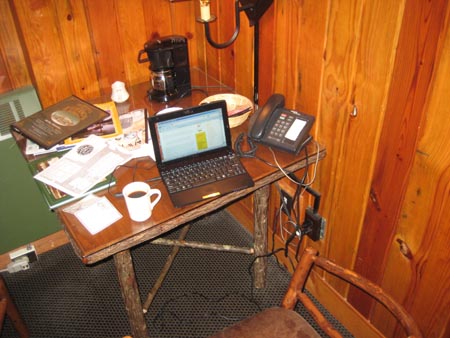
Our workstation in our room at McMenamins Old St. Francis School this morning.
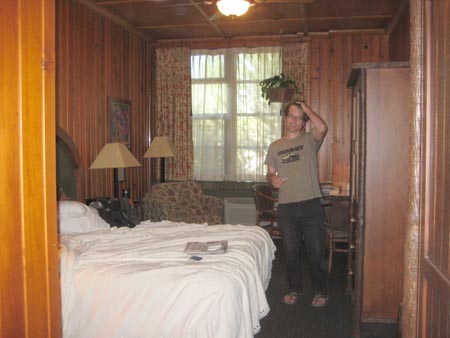
Our room this morning.
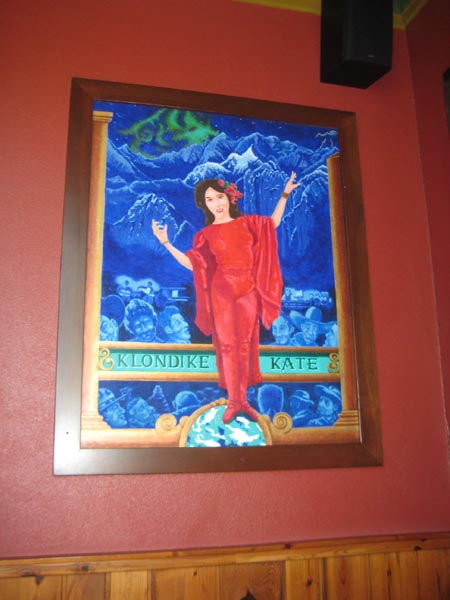
We'd stayed in the Klondike Kate room.
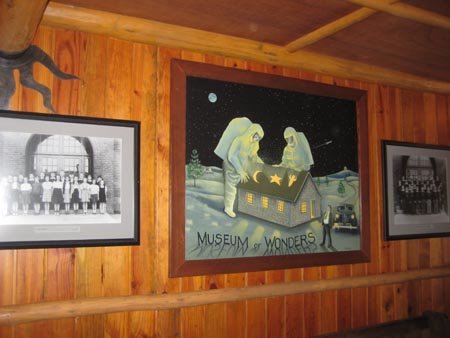
Art in the hallway outside our room at McMenamins.
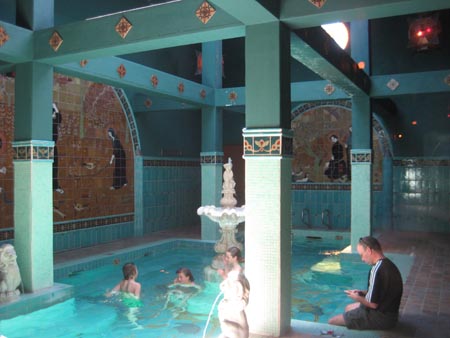
The McMenamins soaking pool.
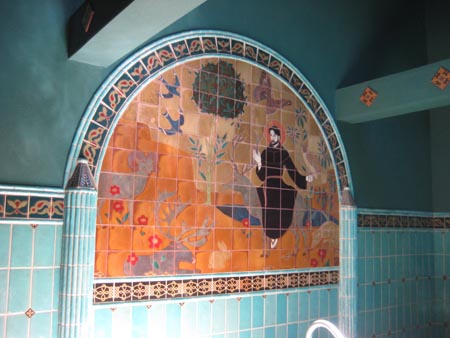
St. Francis-themed mosaic at the McMenamins soaking pool.
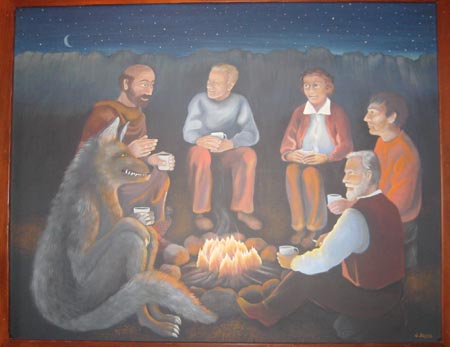
Art honoring St. Francis in a hallway near the McMenamins soaking pool.
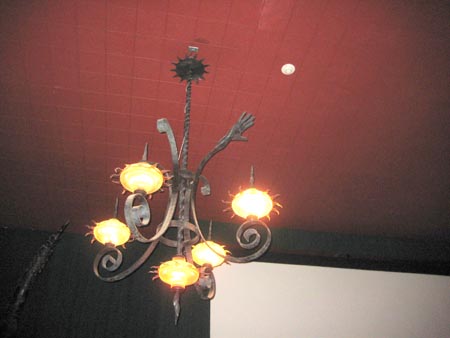
An iron light fixture at the Old St. Francis School.
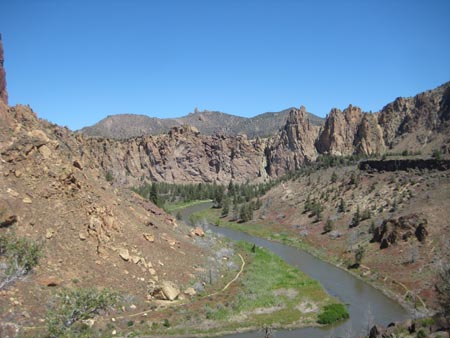
The Crooked River Gorge at Smith Rocks.
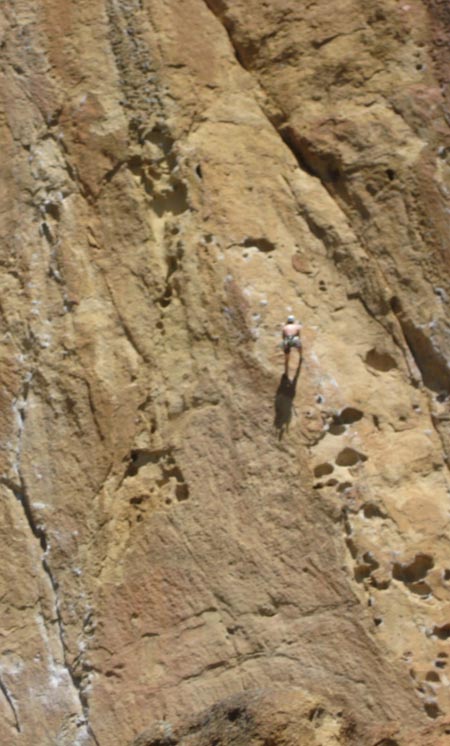
A climber at Smith Rocks.
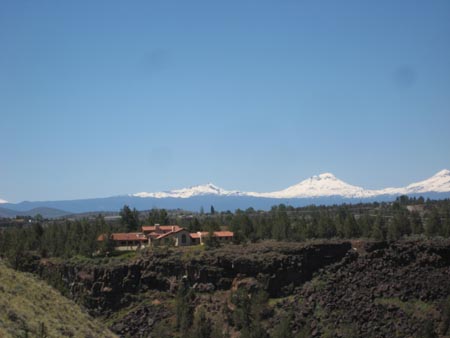
Three Sisters, viewed from Smith Rocks.
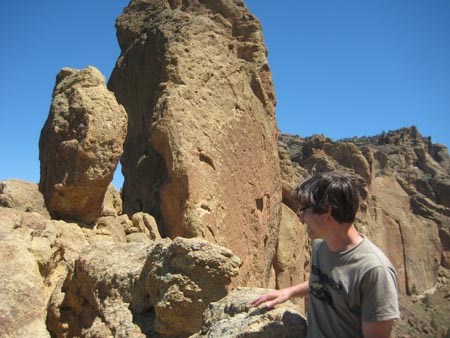
Me at Asterisk Pass in Smith Rocks.
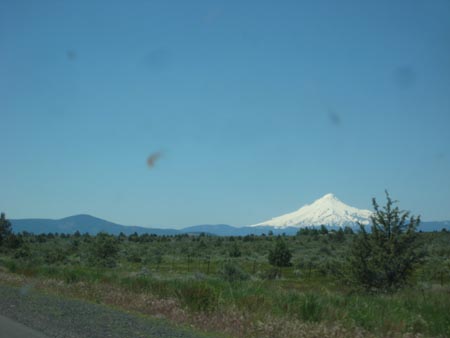
Mt. Hood.
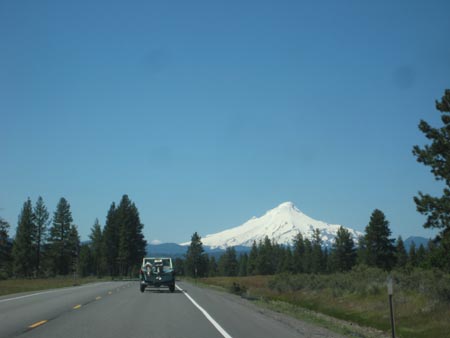
Getting closer to Mt. Hood.
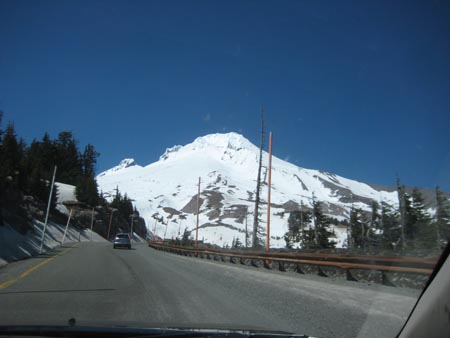
Climbing Mt. Hood.
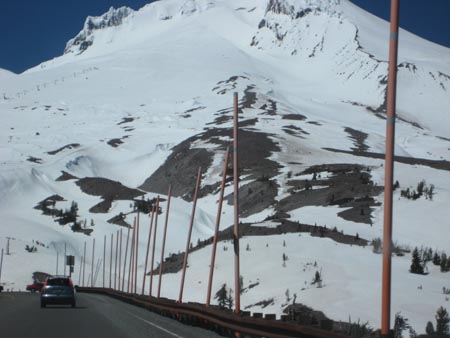
Mt. Hood!
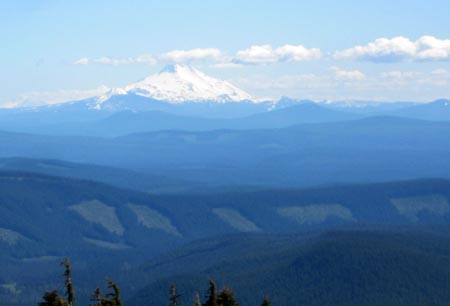
Remote Mt. Jefferson (and some foreground clearcuts) viewed from Mt. Hood. There is no lodge atop Mt. Jefferson.
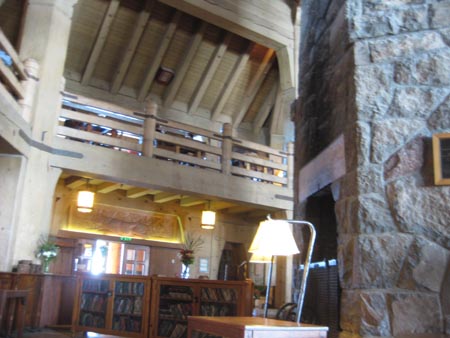
The great hall and its central chimney in Timberline Lodge.
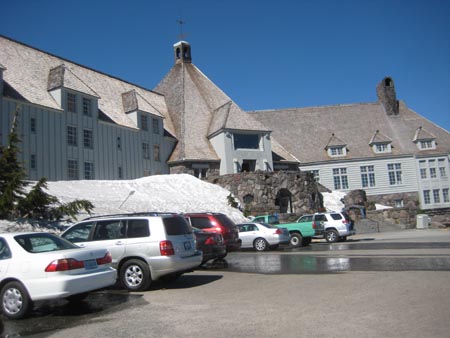
The outside of the Timberline Lodge.
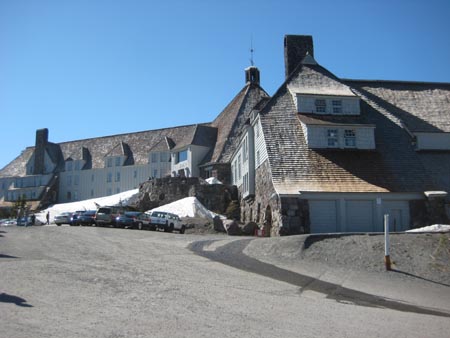
The Timberline Lodge, viewed from the southeast.
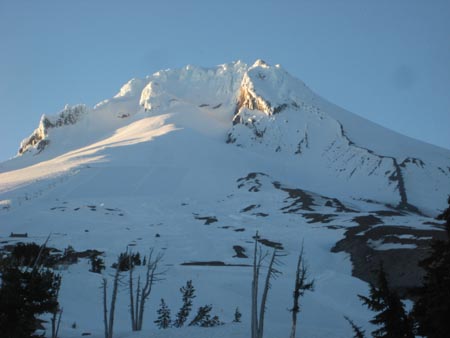
The peak from our dinner spot.
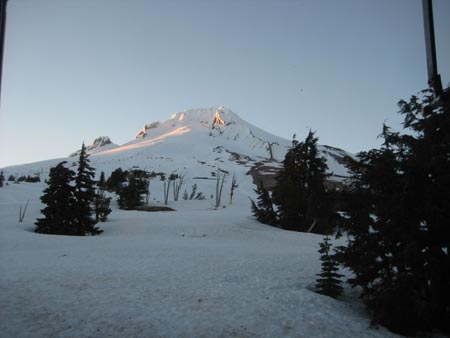
A wider view.
For linking purposes this article's URL is:
http://asecular.com/blog.php?100613 feedback
previous | next |





















